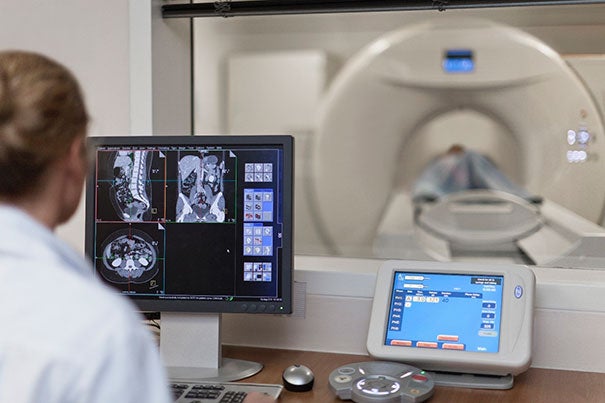Digitizing integrated patient care
 |
| PHOTO COURTESY OF CTAM Health IT departments are being challenged to find network solutions that can handle growing health care demands, such as high-resolution medical imagery and electronic health records. |
The digitization of health care services is having an explosive impact on telecommunications infrastructure for hospitals and health systems. From high-resolution medical imagery to electronic health records (EHRs), telemedicine and more, the amount of data traversing health care networks has grown exponentially, and it's putting a strain on many health care information technology (IT) departments.
In addition, a number of health care institutions are sending medical data to and from more locations as physician and partner networks expand. Health care employees are demanding the ability to transfer files faster and farther than ever before to improve integrated care methods.
Fortunately, new network technologies are replacing the outdated T1 and digital subscriber lines that have fed health care systems for years. Cable companies offer the next generation in connectivity through Ethernet systems and dedicated Internet access service. With these secure, flexible and high-performance networking solutions, cable providers can deliver an infrastructure foundation tailored to meet the growing digital demands of the medical industry.
Case Study 1: Inspira Health Network
Inspira Health Network is a nonprofit health organization that provides primary, emergent and specialty care to patients at more than 60 facilities throughout five southern New Jersey counties. Its employees use the latest medical technology to annually treat nearly 35,000 patients and more than 168,000 emergency department visitors, perform more than 18,000 surgeries and deliver 3,200 babies.
Created after the merger of two of New Jersey’s premier health care systems — South Jersey Healthcare (SJH) and Underwood-Memorial Hospital — Inspira has a strong foothold in the region with three medical centers, three health centers and dozens of outpatient sites.
The organization aims to deliver the best and most affordable care. To meet that standard, Inspira uses EHRs, high-resolution radiology images and other technology-based offerings as part of its standard operating procedure. As such, employees — especially the medical staff delivering care to patients — need a dependable network service that can transfer large data files quickly so they can serve patients with ease.
The merging of SJH and Underwood-Memorial Hospital improved the medical care available to patients in the region, but it also presented a clear challenge to the new Inspira Health Network.
Inspira had to integrate networks seamlessly to connect SJH’s and Underwood-Memorial’s facilities. Inspira also needed scalable capacity to accommodate transfer of bandwidth-intensive patient data among medical centers, health centers and physician offices. It also needed to support patient-facing initiatives, such as the creation of a dedicated portal that would allow patients to view their health records and other documents, and to communicate directly with health care professionals.
Inspira worked with Comcast to link the merged facilities using a wide area network solution that combined several different Ethernet services.
“One of the great things about our … Ethernet services is the ability to reroute our data traffic through a separate private line to access our files from any of our connected locations,” Tom Pacek, vice president and CIO, says. “This, combined with being able to quickly scale up our bandwidth with a simple phone call instead of a site visit, has allowed our doctors and nurses to be more responsive to our patients by having all the information at their fingertips, regardless of location.
“[The] Ethernet services have proven to be extremely dependable,” Pacek adds. “As we acquire new practices, having a technology partner that can provide us with consistent connectivity, high speeds and vast network coverage will allow us to continue to make necessary technological advances so that we can remain a premier health network.”
 |
| PHOTO COURTESY OF CTAM Hospitals are integrating electronic health records into their daily operations to provide patients a better care experience.
|
Case Study 2: Grady Health System
Grady Health System stands as one of the largest public health systems in the United States. Its facilities include Grady Memorial Hospital (formerly Grady Hospital), the largest hospital in Georgia, with a license for 953 beds. It also is a premier Level I trauma center serving the metro Atlanta area. In addition, the health system operates six neighborhood health centers, an outpatient pharmacy, Crestview Health & Rehabilitation Center, and Grady EMS, Atlanta’s 9-1-1 ambulance service that responds to more than 100,000 calls each year.
Grady is well-recognized throughout Georgia for its trauma center and other innovative programs. As the health system has grown over the years, so has its supporting network infrastructure and services, which are required to sustain a modern health care system. Grady sourced a number of services from different providers — from T1 to Ethernet services — to connect its facilities, which made network management, maintenance and billing extremely complex.
“We needed to modernize our network infrastructure across all of our facilities in order to effectively deliver digital health care services to all of our patients," says Kevin Yearick, director of network services at Grady Health System.
Grady already was using Comcast Business TV across its facilities. Based on this positive experience — and the fact that the company could deliver fiber-based Ethernet services to each location versus the continued patchwork approach — Grady decided to expand its relationship with Comcast to upgrade its infrastructure.
Installing an Ethernet service provided 300 megabits per second (Mbps) of scalable capacity to Grady’s data centers and 50 Mbps connections to 15 other remote sites to enhance connectivity between facilities. Grady also added an Ethernet-dedicated Internet line that provides a 100-Mbps connection to the Internet. As the sole service provider for Grady’s vast network footprint, Grady was now able to reach out to one vendor for support services for improved response time. It also simplified the billing and vendor management process by using a single vendor for Ethernet and TV services.
“Comcast Business Ethernet services give us five times more bandwidth than we had before at a low cost,” Yearick adds. “And it helped us to simplify our network infrastructure while streamlining the support services associated with change control, and the other administrative functions, which is important in an organization this large.”
Prior to having the new system, Grady’s larger facilities had adequate bandwidth to access and transmit digital patient records, but it was difficult, if not impossible, for its smaller facilities. Now, high-performance Ethernet is providing network capacity and connectivity for Grady’s remote offices to use EHRs, picture archiving and communication systems, and telemedicine programs for its patients. These programs enable real-time transfer of digital health records and high-resolution radiology files, which help to improve the speed of diagnosis and information-sharing among Grady health care professionals to enhance patient care.
“We really don’t know what new digital health care technology will be coming down the pike, but … we know we have the right service partner in place to take advantage of it, whatever it may be,” Yearick adds.
 |
| PHOTO COURTESY OF CTAM Flexible and scalable networking solutions allow lab results to be transmitted in milliseconds and can replace outdated communication means, such as faxing and courier services.
|
Case Study 3: SaraPath Diagnostics
SaraPath Diagnostics provides individualized pathology specialty services and operates in an extremely aggressive marketplace. Because it competes with nationwide corporations boasting clinical laboratories in most major U.S. cities, SaraPath Diagnostics must process and deliver lab results quickly and efficiently. Otherwise the hospitals, medical practices and patients it serves may consider another provider.
Like many medium-sized businesses, SaraPath Diagnostics implemented T1 and digital subscriber lines for communication purposes and Internet access. Because this system didn’t provide the necessary bandwidth for a growing pathology practice, results were either faxed or sent via courier to hospitals and medical practices, which sometimes took hours. That’s when the IT team began looking for a more flexible and scalable networking solution.
At first, Mark J. Pelea, IT manager at SaraPath, and his colleagues considered building and managing a network in-house, but that proved to be costly and time-consuming with regard to hardware upgrades and maintenance.
The company chose a system that securely connected its three main sites through Comcast’s business Ethernet service that provided a fast and reliable Internet connection with scalable bandwidth sufficient to transmit these images. Now the results are transmitted in milliseconds.
“Comcast offered us a more scalable and practical solution,” Pelea explains. “And it is working exactly as we expected. When it’s time to add more remote sites and support more customers, we’ll scale the network. This is a fairly simple process, as opposed to enduring multiple equipment changes if we had built our own network.”
In addition to helping SaraPath Diagnostics deliver pathology results more quickly and efficiently, the service helps to support the organization’s growing customer base by providing the necessary bandwidth for additional B2B and Web-based solutions for hospitals and medical practices.
The Ethernet service also provides the bandwidth needed to balance server loads for disaster recovery initiatives and to support telepathology services, which place SaraPath on the cutting edge in its field.
 |
| PHOTO COURTESY OF CTAM Instant connectivity across hospital sites helps streamline communication among care team members and facilitate integrated care.
|
Cable makes next-gen digital health care services possible
Cable companies are uniquely positioned to enable next-generation digital health care initiatives. By offering secure, robust and redundant network connectivity, cable provides the telecommunications infrastructure health care facilities need to manage EHRs, collaborative diagnostic practices and disaster recovery efforts. With high-performance Ethernet and dedicated Internet access offerings, cable is powering the digital services that are critical to patient care.
Alexandra Sewell is executive director, emerging markets, Comcast Business.




